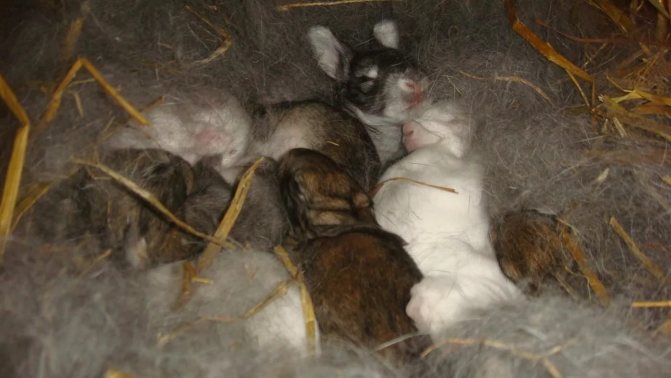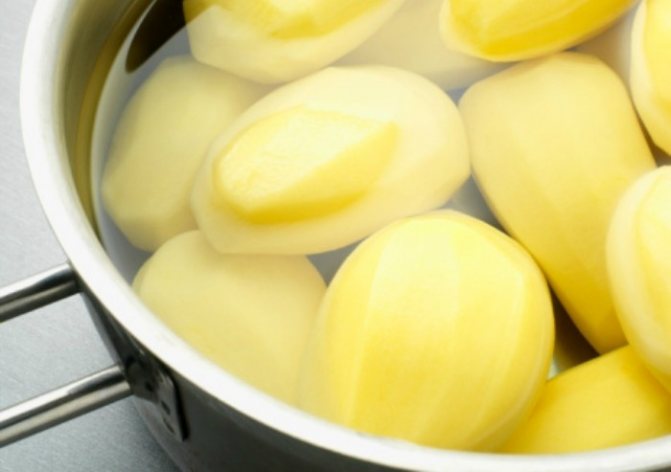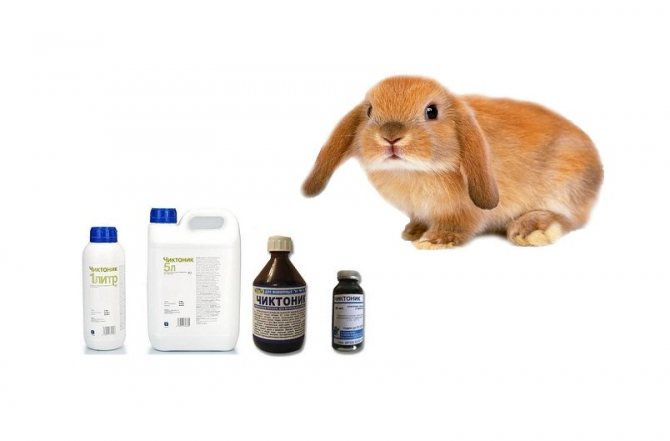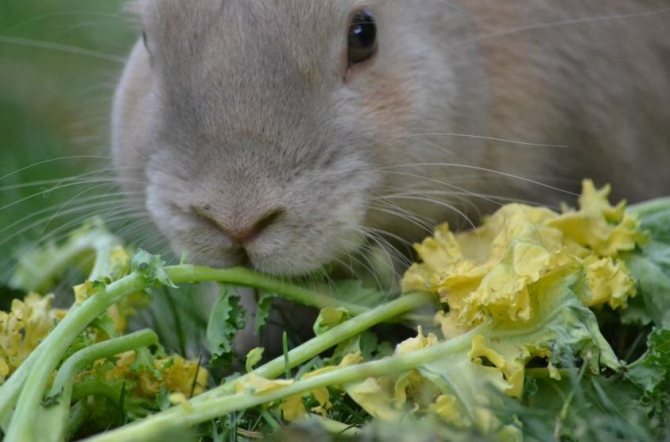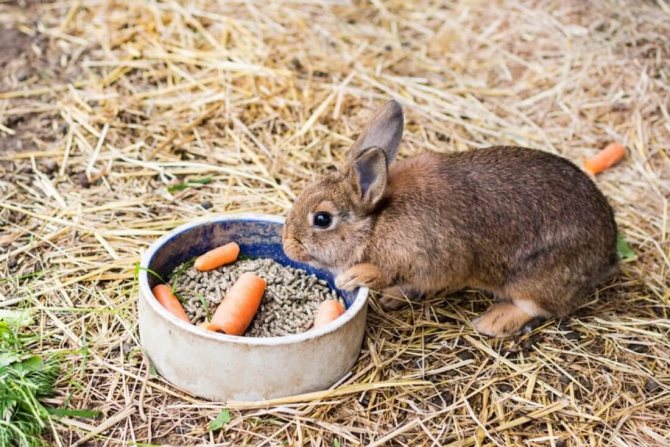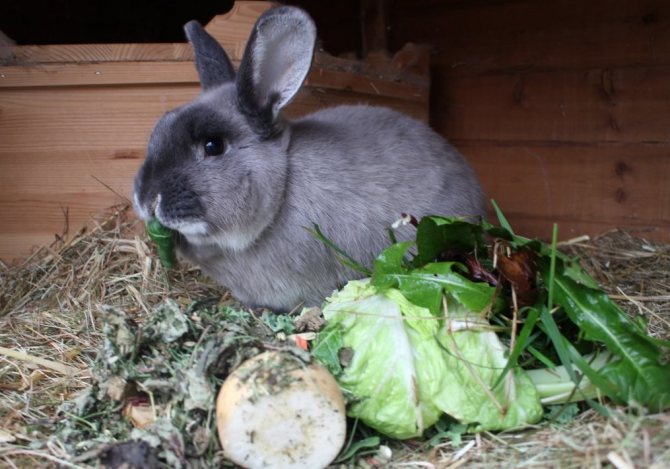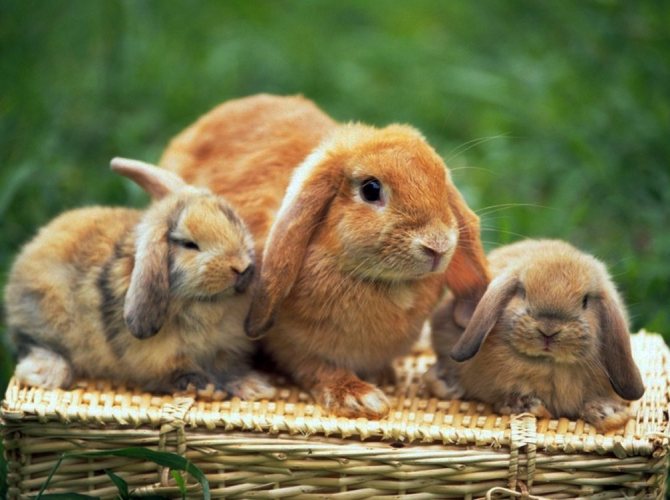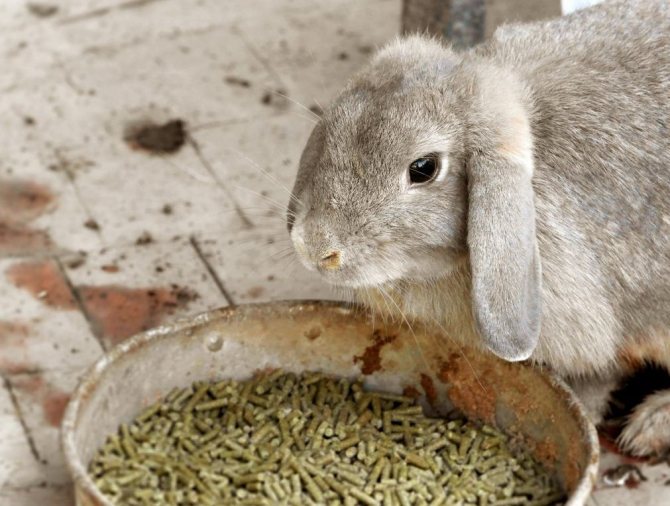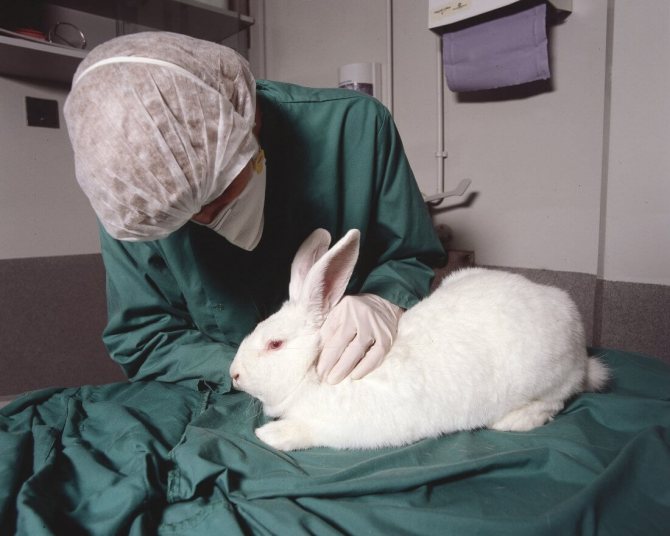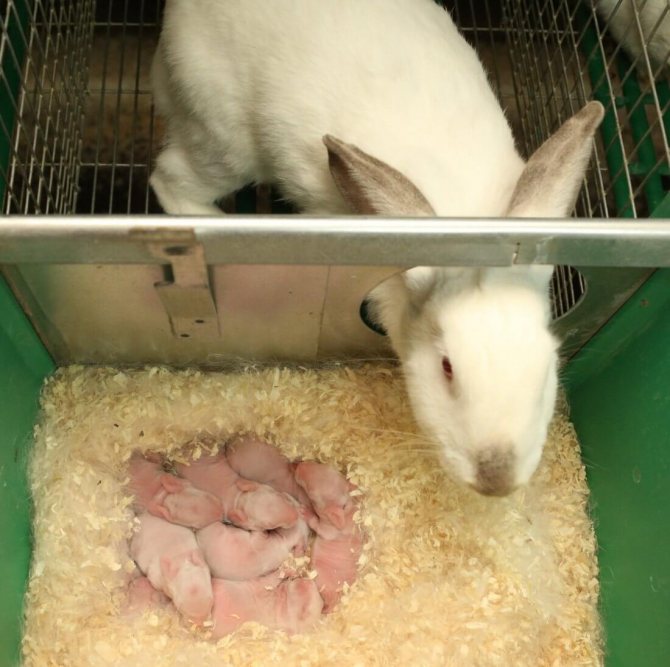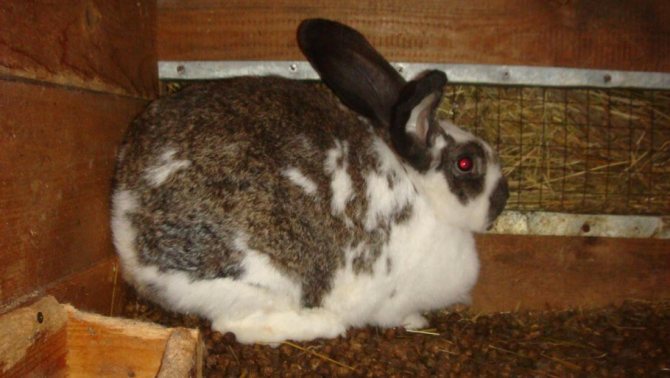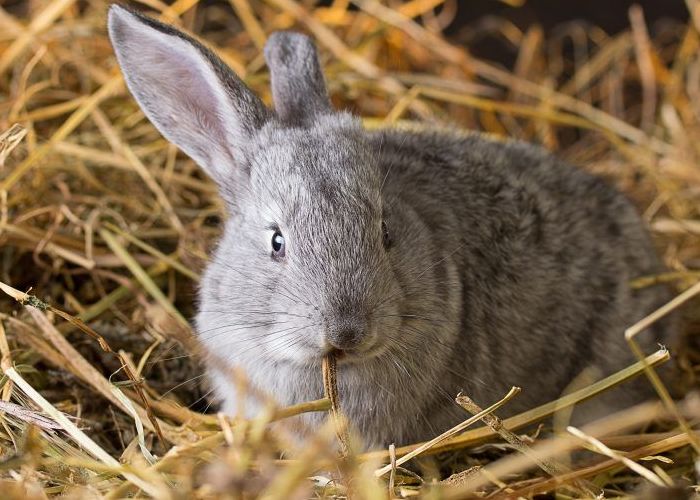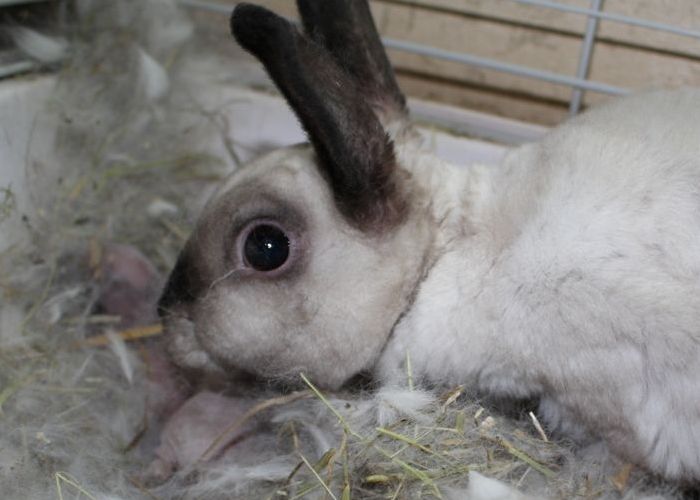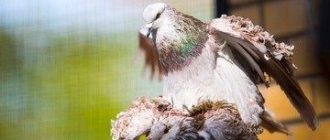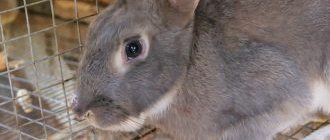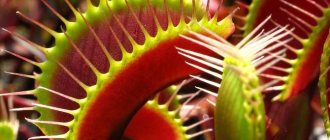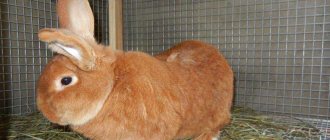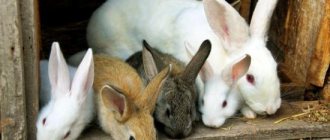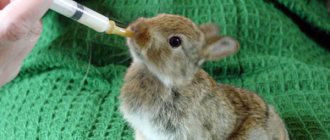/ Breeding / How to feed a rabbit after birth to increase lactation
0
5695
Article rating
Carrying rabbits and their birth is a very important period during which the female rabbit needs special careful care: living conditions, nutrition, etc. Every rabbit breeder should know everything about the female's diet during pregnancy, as well as what to feed the rabbit after birth.
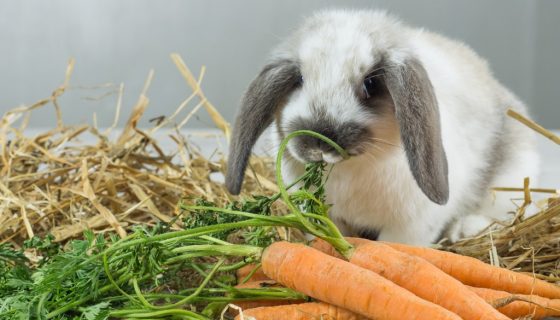
How to feed a rabbit after birth
Diet of the female before giving birth
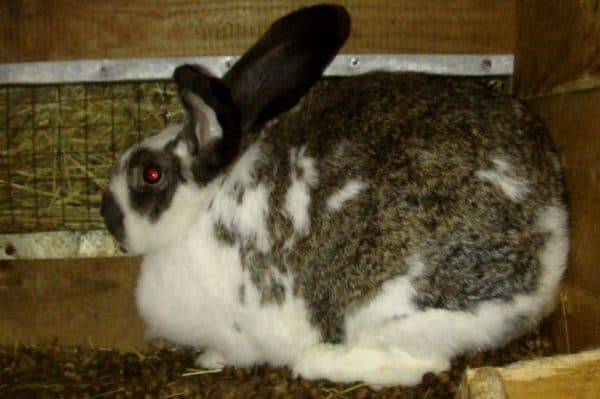

Rabbits are very fertile
The composition of the rabbit's food must be changed before mating, so that her body gets used to a different regimen. The feed should not get bigger, but it should be enriched with minerals and vitamins. Access to fresh and cool water around the clock is essential.
The main diet of a sucrol individual is green food: grass (to prevent bloating, freshly cut grass must be dried), carrots, cabbage, pumpkin. One individual needs about 300 g of greens and vegetables per day.
To this volume should be added:
- 1 g salt;
- 1 g fish oil;
- 1.7 g of chalk;
- 7 g bone meal;
- 5 g yeast;
- 35 g sunflower meal;
- 5 g sunflower meal.
Attention! Herbs such as celandine, dope, buttercup, milestones are very dangerous for rabbits.
Case
It is best to mate in the morning in the summer. It is the female that is planted to the male, and not vice versa. First, the feeder and drinker should be removed from the cage. Immediately after the end of the process, you need to plant the female in a separate cell. If it did not work out to bring the pair together, then the female is placed next to the male again, and, preferably, to another one.
When mating is done, care must be taken to ensure that mating takes place. After 5 days, a control mating is carried out. If the female stopped letting the rabbit go, then the first mating was successful. Fulfillment is checked by probing the female's abdomen. In a pregnant rabbit, the back of the abdomen is denser.
The procedure is performed 10-12 days after mating. At this moment, the uterine horns are already enlarged and are gradually filled with fluid in which the embryos are located. On palpation, you can feel the embryos, they are like grapes, elastic oval in shape.
Feeding for a lactating female
The main task of the rabbit is to feed the offspring.
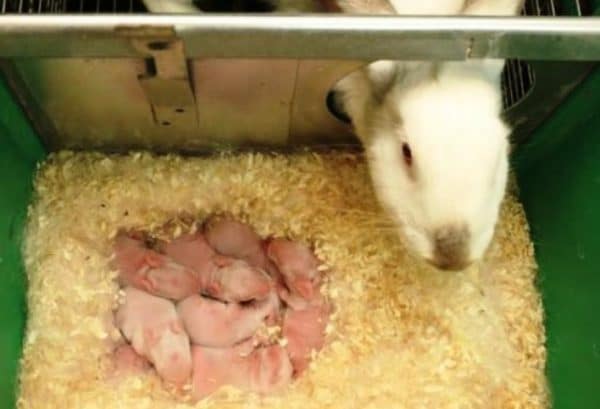

Additionally, you need to add cereals (oats, barley, wheat) to the mash and feed the female with milk of a cow or goat
The lactating female gradually gives less milk, that is, in the first 15 days, the volume of lactation is 60% of the total amount of milk for the entire period, and the next 15 days, the amount decreases to 40%. The amount of food fed to the uterus depends on the number of newborns.
After a month, lactation stops, because the month-old cub switches to adult food and does not need milk. The basis of nutrition will be the same components as for felted individuals.
Additionally, you need to add cereals (oats, barley, wheat) to the mash and feed the female with milk of a cow or goat... A three-week-old rabbit begins to eat food with its mother.
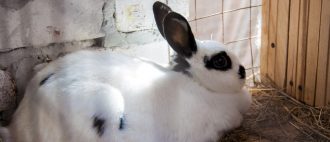

Be sure to read:
How to understand that a rabbit is pregnant, and what to do next
Approximate daily menu after okrol
After giving birth, the uterus needs more feed, and it is slightly different in composition.
An approximate diet for the day is as follows:
- 300 g of dried fresh or dry herbs;
- 50 g of sunflower waste;
- 30 g sunflower meal (or cereal bran);
- 5 g nutritional yeast;
- 80 g of combined feed;
- 7 g bone meal;
- 3 g of chalk;
- 4 g vitamins A and E (fish oil).
- 2.5 g salt.
Until the end of the rearing of the offspring, the amount of feed should reach 700 g per day. In the first 7-10 days, 350 g per head is enough, in the next 10 days it will take about 450 g, in the third decade - from 550 to 700 g.
This also includes food eaten by rabbits in parallel with breast milk.
What to feed after wintering?
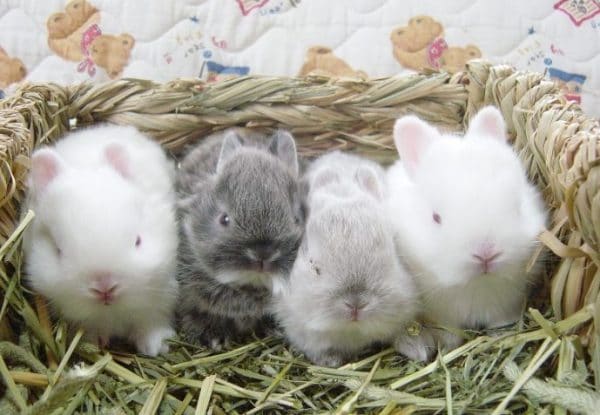

It is good to add nettle and wormwood as a vitamin supplement.
In the cold season, fresh grass disappears from the diet of rabbits. It is replaced by hay, potatoes, grain, corn, silage, sunflower waste or legumes. It is good to add nettle and wormwood as a vitamin supplement.
For example, you can give the following proportions:
- 200 g potatoes;
- 40 g of bran;
- 30 g of cake;
- 70 g of grain;
- mineral supplements.
Percentage diet:
- 66% hay, grain and potatoes;
- 12% bran;
- 10% corn;
- 10% alfalfa flour;
- 2% mineral supplements.
In winter, the amount of feed should be increased by about 50 g per female. It is useful to feed a lactating animal with root crops. The exception is red beets.
How many times a day to feed the rabbit
The female feeds the offspring 2-3 times a day. She produces from 50 to 270 g of milk. Milk production increases as the young rabbits age.
Based on this, the rabbit should be fed at least 3 times a day. It is recommended to feed her even more often. It is important to stick to your feeding schedule. The sufficiency and frequency of feeding can be adjusted depending on the well-being of the uterus and the development of the cubs.
Possible problems
If the pregnant female is undernourished or if the diet is unbalanced, they may develop toxicosis, which is characterized by the lethargy of the animal, impaired coordination and convulsions, which can even lead to death.
Devouring of newborn rabbits by the female can also happen. The reason lies in the nervousness of the female, as well as in the lack of moisture (or the rabbit does not drink because of stress) and minerals in the feed.
Overfeeding the expectant mother can lead to obesity and non-viability of the litter.
For the birth of a viable and healthy rabbit offspring, it is important to properly feed the rabbit during pregnancy and lactation. You can also increase the level of milk production for feeding babies by increasing and correctly forming the female's diet.
Rabbits are very fertile. From one rabbit and her offspring, you can get up to 800 rabbits per year. Double pregnancy and double birth (superfetation) also occur, that is, the female can become pregnant again when she is already pregnant.
True, competent breeders do not allow such frequent reproduction of females. It can happen no more than 4 times a year. A novice rabbit breeder needs to know how the pregnancy and childbirth of a rabbit go.
The composition of the diet of the lactating female: concentrated feed and mash
A nursing mother loses a large amount of trace elements during lactation. To diversify the diet, breeders try to feed their wards with combined feed.
For this, cereals (wheat, oats, bran), legumes, silage and cake are ground, mixed with crushed vegetables and flavored with vitamins and minerals. Such feeds make up about 90% of the total diet.
On a note! The sufficiency of nutrition of the uterus can be judged by the appearance of the babies. If the rabbit is well-fed and calm, then the rabbit eats right.
What to feed?
How many meals a day should there be? The more often the better. Meals should take place at the same time. The choice of feed directly depends on the season.
Summer period
In summer, the nutrition problem is solved much easier than in winter, because nature is generous with roots, fragrant herbs, young grain shoots, etc. The basis of the diet of a nursing rabbit at this time is alfalfa, meadow grass, oats, clover, cabbage leaves, Jerusalem artichoke, etc. You can give vegetables or vegetable tops, and green peas, beans, corn, etc. are welcomed as protein foods.
What to do if milk is not enough
Rabbits' milk is very fatty (about 15%). Even three meals a day allows children to grow and develop well. If the rabbits constantly squeak, randomly run around the nest, have a thin belly with folded skin, then they do not have enough nutrition.
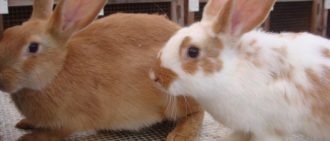

Be sure to read:
Breeding rabbits at home for beginners
To increase lactation, the rabbit should be added to the mash dill, elecampane, rowan berries, dandelion, clover, nettle or sedge, increase the amount of vegetables and fruits in the diet. Oxytocin is sometimes given by injection.
Babies may starve due to the stress of the mother, although she has enough milk. Then you need to provide the female with normal conditions of detention. If the nervousness is caused by sexual desire, then you need to mate.
Expert advice
Following these recommendations will allow not only to grow healthy rabbit offspring, but also often save the lives of those weak babies who, by all indications, would have to die.
- If you do not monitor the container with water and allow it to remain empty, the female can eat the newborn rabbits.
- She does not disdain her own cubs (no matter how many of them there are) even when there are few mineral supplements and vitamins in the food.
- In order for the mother to feel comfortable feeding the babies, she should build a comfortable bed (especially in winter) according to the mink principle and protect the walls from drafts.
Read also: Using cow dung as fertilizer
It also happens that orphan rabbits need to be "attached" to another rabbit. Or one eared mother does not have enough milk, while the other has too much of it. Strangers should be placed in the center, covered with fluff, which covered other rabbits and left for several hours. During this time, their bodies will acquire the same smell as that of their eared relatives.
How rabbits give birth in summer and winter
In summer, the okrol of a rabbit is harder... Animals do not tolerate heat well, so childbirth takes place at night. Even mating of animals is recommended during cooler hours.
Before giving birth, you should check the nest in the mother liquor. Excess fluff must be removed so that the kids do not crawl in search of coolness. During this period, the female needs more greenery to produce milk.
In cold weather, the strongest cubs are born. Okrol is easier. Rabbits grow resistant to low temperatures. In cold weather, the female has low sexual activity, and she is completely absorbed by the feeding of the offspring. For winter breeding, a large re-giving birth female and a strong male are optimal.
Of the babies born, it is advised to leave as many working nipples as the rabbit has. This measure increases the chances of full feeding of the offspring. It is necessary to ensure that there is always hay, combined feed and fresh water in the cage.
Usually the female eats the afterbirth, this is a natural behavior. The placenta is rich in hormones necessary for lactation and restoration of the female's reproductive system.
Childbirth with cell maintenance
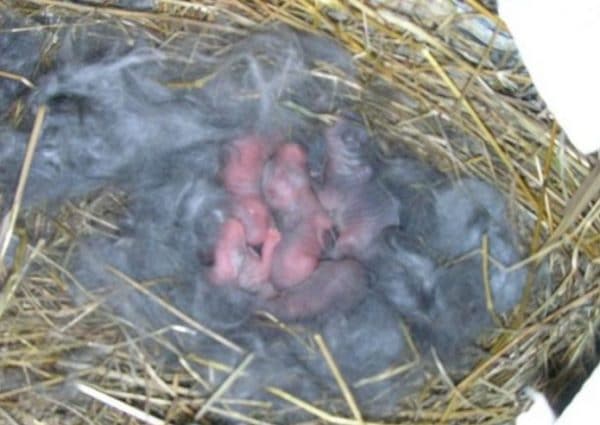

Usually the female eats the afterbirth, this is a natural behavior
The cage content of rabbits is the most widespread.
When constructing a cage, you need to take into account the following points:
- cage dimensions (length - 1.80 m, width - 1 m, height - 0.65 m);
- height from ground to floor (about 50 cm);
- temperature regime (not lower than +6 ° С);
- illumination (at least 16-17 hours a day).
Before giving birth, the uterus has decreased mobility.If 28-33 days have passed since the day of mating, we can talk about the beginning of labor. In order to avoid the loss of offspring (in stress, the rabbit can eat her cubs) the cage should be covered with dense material.


Be sure to read:
Dressing rabbit skins at home: step-by-step instructions for processing
In solitude, the animal will calmly give birth, lick, feed and cover the babies in peace.
Okrol in holes and holes
In nature, animals live and breed in burrows. Children raised in this way are the strongest. But in this case, it is impossible to control the mating of pets and the birth of rabbits.
Rabbit breeders sometimes use the conditions of keeping animals as close to natural conditions as possible and build artificial burrows. The street cage is connected by a hole to a burrow inside a warm barn. This keeps the nest warm, and fresh air and light comes from the side of the cage.
The birth of baby rabbits
Childbirth begins with weak contractions, then the attacks intensify and turn into attempts, labor begins. Since the female has a two-horned uterus, the babies come out alternately from each horn, or first one cavity is released, then the second.
The process can take about half an hour.
Labor is complete when the uterus:
- gnaws through the umbilical cord;
- eats the placenta;
- licks the cubs and arranges them in the nest (covers them with fluff).
Important! The rabbit loses a lot of energy during childbirth and is very thirsty. Lack of water in the cage can lead to eating of newborns.
Features of feeding rabbits
You should pay special attention to these points.
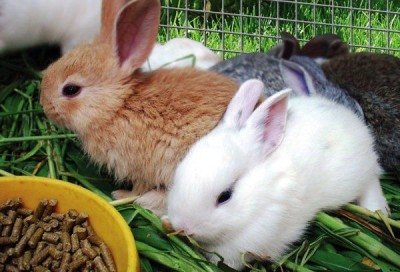

If there is not enough milk
Newborn rabbits need up to 5 ml. milk a day. If babies are applied to a female 5 times a day, it turns out that they should eat 1 ml in 1 approach. nutrient fluid. How much milk does the rabbit produce? The female produces from 50 to 270 grams. milk per day. It is necessary to ensure that babies eat their mother's milk at least 2-3 times a day, especially in the first 2 decades of lactation, when milk production reaches up to 61% of the total milk volume during lactation.
How can you know that babies are short of milk? They are lethargic, emaciated, squeak loudly, the skin on their tummies wrinkles. Well-fed rabbits are immediately visible: puffy tummies, the skin is straightened, they quickly become covered with their first fur.
In order to increase the amount of milk produced per day in winter and in summer, the rabbit should be given more protein and vitamin food, so that there is "fuel" for converting it into milk. Dill, parsley and elecampane have excellent milk-producing properties. They can be added to the mash.
Feeding problems and solutions
A rabbit who sits aside from newborn babies and stubbornly ignores them can do this for the following reasons:
- A hormonal failure has occurred (in this case, experienced breeders advise to mate a female with a male - the hormonal level returns to normal and the female calms down.
- Postponed stress, fear, a sense of threat (this happens when the rest of the female is constantly disturbed, the rabbits are taken out, they are often removed in the cage, etc.);
- The firstborn female may refuse to feed the cubs due to the lack of maternal instinct.
To solve the problem in the latter case, the rabbit needs to be transferred to a warm place and create comfortable conditions for feeding, turn her over on her back so that there is no interference for the babies and put them one by one to the nipples.
Particular attention should be paid to whether lactation is successful.... This can be verified by pressing lightly on each nipple. A small drop of milk should come out. If a malfunction occurs in the body, the female looks thin, the skin on the abdomen is wrinkled, the behavior is lethargic and indifferent, or, on the contrary, very aggressive.
Rabbit and offspring care
In the first days after birth, special attention should be paid to the uterus and babies. The latter can crawl out of the nest and freeze. And the woman in labor needs to check the lactation.
To do this, you need to alternately press on the nipples. If droplets of milk are released, then everything is fine. You should also track the feeding process. Sometimes, because of soreness, the mother may not let the cubs near the nipples. A rabbit with cubs needs to provide calm conditions. There should be enough food and water in the cage.
Preparation for okrol
A few days before the start of okrol, the pregnant female begins to equip the nest, that is, she collects straw in a certain part of the cage, lines the selected corner with fluff from the belly. She should be helped to make a comfortable place to stay with newborn rabbits.
To ensure the rabbit a comfortable stay after giving birth, care should be taken to install a nest box in the cage. You can buy it in the store, but it is not difficult to make it yourself from scrap materials. The main thing is that along the perimeter it should be 10 cm more of the female's body. It is in it that the okrol will occur, and for the first time there will be newborn rabbits.
Nest hardware:
- Any cardboard box with a slotted hole will do so that the rabbit can arrange a nest inside. The box should be treated with any disinfectant to avoid the development of pathological microflora.
- The device is installed in the cage almost before the roundabout, making sure that the rabbit does not make a toilet there.
- At the bottom of the box, torn newspapers and sawdust should be laid out, and then hay. There should also be hay in the cage in order to provoke the rabbit to do the arrangement.
The cage insulation measures in winter are more responsibly approached. After all, the offspring is born completely without a down cover, and can freeze in the absence of heating:
- the nest is lined with thick foam around the perimeter
- the bottom and walls of the cage are additionally insulated with insulating material
- a layer of thick felt is lined on the roof
- in severe frosts, the cages are completely covered with old blankets
- install heating devices
The breeder must ensure that the rabbit has constant access to water and food before giving birth. Also, do not forget about installing the nest, because some breeds do not care about arranging a place for nesting. Before giving birth, you can shorten the claws on the paws of the animal so that it does not accidentally injure the skin of the babies.
First aid kit for okrol
Usually rabbits give birth themselves at night. But just in case, the farmer should prepare a set of tools.
In the first aid kit you need to put:
- disinfectant;
- plastic tray for non-viable or dead rabbits;
- gauze napkins, bandages;
- brilliant green or iodine;
- latex gloves;
- scissors;
- strong cotton thread;
- tweezers.
Everything you cook should be on hand at the right time.
Increasing lactation with drugs
Another way to increase lactation is medications. For example, the hormone oxytocin is used, which causes an increase in lactation through uterine contractions. After using it, milk appears within 24 hours.
The use of oxytocin does not guarantee lactation. If all else fails, you need to attach the rabbits to the nursing rabbits or feed them yourself from a pipette. It is very important to ensure that only those born are fed on the first day.

